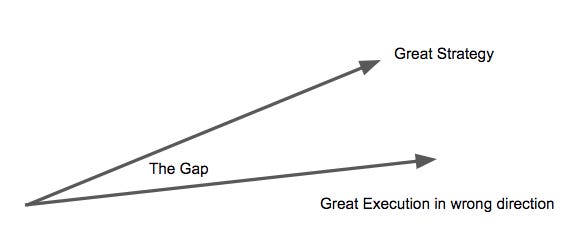The Strategy to Execution Gap
We are already in the second half of 2022 !
So far through Productify, I have published 10 case studies related to the strongest product themes and now in plans for some great writings in the second half of the year too.
The target is to publish another 10 to 15 high quality product, tech and strategy related cases by end of 2022. So if you’re not a subscriber yet, this is the time to sign-up:
In April of 2022, I compiled some well known Product Strategy Frameworks into a single post, but I figured there are two follow-up problems :
Writing a good (and clear) strategy is not enough.
Formulating a great strategy followed by great execution is also not enough.
Let me explain this.
Imagine strategy being the river and the execution being the rowing boat in that river. Strategy dictates in which direction to go and in which direction not to go (river’s flow) and the team’s execution may be great (rowing the boats nicely) but execution maybe going in opposite direction or diagonally to the river flow. The captain of the small boat (and often the leadership) is confused that we know the flow of the river (strategy) and we are rowing boats too (execution) but we are not moving enough in the right direction. That’s why having great strategy and great execution may also not lead to results.
This gap is what I describe simply as Strategy to Execution Gap.
The ‘execution loving’ people simply spend too much time executing and not measuring if the execution outcomes are following the strategy, and the ‘strategy people’ spend too much time on slides and presentations and not observing the learnings from execution that might further inform/modify the strategy.
Let us look at it graphically to further understand this. It is important to note that strategy and execution are directional and are more complex than this graphical representation but for simplicity let us go ahead with it:
Org. / Team has a great strategy but executes in wrong direction , leading to the strategy-execution gap
2. Org/Team improves its execution but ‘execution people’ continue to be not aligned to ‘strategy people’.
3. Org/Team figures out the gap and they start either iterating on strategy or the execution to bring the both closer together directionally, hence reducing the strategy - execution gap
Reducing the gap
The beauty of pictorial representation above is that is boils down the solutions to some simple fundamentals:
Align Execution (people/processes) with Strategy through reviews and metrics
Have strategy and execution plans together and not at two different places
Align the whole org. on what’s the strategy and how do we plan to achieve it
Let us dig into each one of these. And if you haven’t subscribed yet, this is a good time to become part of Productify community:
Align Execution (people/processes) with Strategy
Generally most teams setup multiple ‘syncups’ weekly/monthly and so on to ensure that execution is running on track and is meeting strategic goals too. These syncups solve the aspect about bringing cross-functional teams together but may still not solve for the directional gap between execution and strategy.
There is a need to run these syncups in a way that each one of them continues to add to the velocity (of execution moving closer to strategy) rather than just being updates/blockers.
Rethinking your operating cadence (Reforge / Written by Elena Verna and Keya Patel) is a great piece on how companies and teams should operate while ensuring that all actions are aligned to organisational outcomes.
Have strategy and execution plans at one place
No matter how great the company strategy and execution is - if both are not being tracked together, it will always lead to the gap.
Teams and organisations can make sure that wherever they track the ongoing features/hypothesis etc., it is always mapped to the metric that is linked to meeting the overall strategy. A good policy would be ‘no product discussion without the impacted metric’. This ensures that you’re always prioritising impact in right direction, and not just any impact.
In order to have strategic bets and tactics/features in one place, I recommend reading Outcome-based roadmaps written by Gibson Biddle.
Align the whole org. on what’s the strategy and how do we plan to achieve it
There’s no better motivation than informing and empowering team members on how their work impacts the company through series of metrics.
Personally, I feel OKRs give the best chance to a company to communicate strategy through a series of well-crafted Objectives and Key Results.
If you’re interested to know more about crafting OKRs, you can read the case study I wrote on OKRs (Chip Wars that led to birth of OKRs)
Also, here are some lessons and visuals from John Doerr himself (author of measure what matters)
If you liked this post, please do share on your social media and you could tag me on LinkedIn/Twitter:
And if you have questions to ask/ thoughts / comments, please comment and I will for sure respond:
And would love if you can tap on the heart icon at the bottom of this article so that the writings can reach more people. :)
Cheers,
Bandan (Twitter | Productify Substack)





